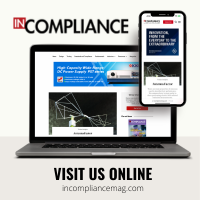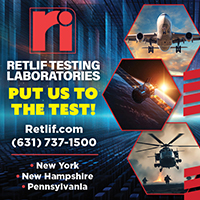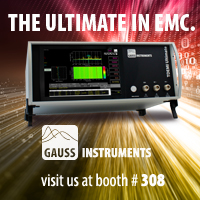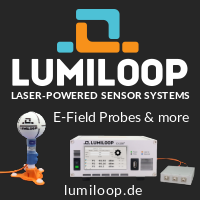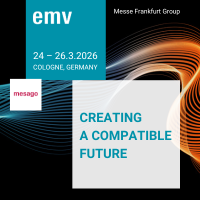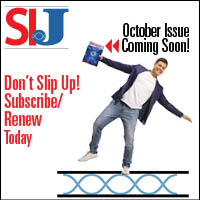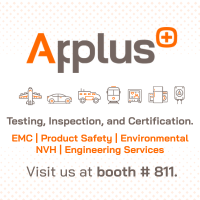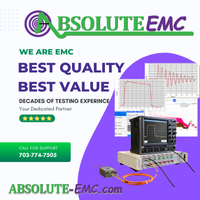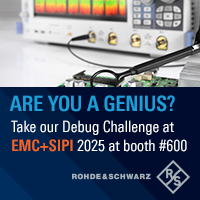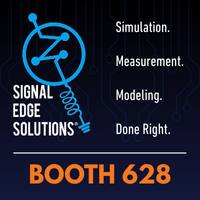Workshops & Tutorials
We are pleased to announce the following Workshops and Tutorials sessions planned for the Symposium. Please check the FINAL PROGRAM for the full details and abstracts. The Workshops and Tutorials will be scheduled throughout the week to accommodate the overwhelming number of excellent sessions. Attend one of the most popular attractions in the Technical Program!
Monday, August 18, 2025
(WT_A1) Advanced Materials for Aerospace EMC and Other EMI/EMC Applications
Sponsored by TC-11
Chair: Marina Koledintseva, The Boeing Company, Saint Louis, MO
Location: 302C
Time: 8:30 AM – 12:00 PM
Abstract: In this workshop, presentations will focus on physics, technology, characterization, and EMC applications of new advanced materials, including nano-materials, metamaterials, and various composites. Such materials are used, in particular, for design of EMI shielding and filtering structures and various electromagnetic wave absorbers.
(WT_A2) Military EMC
Sponsored by TC-3
Co-Chair: Robert Davis, Lockheed Martin, Retired
Co-Chair: Carl Hager, NSWC Dahlgren
Location: 303
Time: 8:30 AM – 5:00 PM
Abstract: Achieving electromagnetic compatibility with military equipment, systems, and platforms requires significant expertise and effort. EMC must be considered at all lifecycle stages and involves first characterizing the operational electromagnetic environment (EME), then design/testing military systems at various stages of production, assembly and integration and coordination of Spectrum in operational environments.
(WT_A3) Introduction to Modeling Techniques for EMC+SIPI Problems
Sponsored by TC-9
Chair: Giulio Antonini, Universita degli Studi dell’Aquila
Location: 305A
Time: 8:30 AM – 12:00 PM
Abstract: This tutorial will introduce commonly used numerical modeling techniques for EMC+SIPI problems without the need for detailed math. Practicing modelers will also benefit from learning the fundamentals of modeling techniques they are currently not using. Each technique will be presented with strengths and weaknesses so engineers can decide which techniques are appropriate for their problems.
(WT_A4) When Open Source Meets SIPI/EMC
Sponsored by TC-9
Chair: Yansheng Wang, Rivos Inc.
Co-Chair: Giorgi Maghlakelidze, NVIDIA Corp.
Location: 305B
Time: 8:30 AM – 5:00 PM
Abstract: Open source is gaining increasing attention these days, with well-known projects like Linux and RISC-V leading the way. But how can the SIPI/EMC community contribute to and benefit from this growing open-source movement? Join us for this workshop to find out. We’ll introduce several open-source projects and tools specifically developed for the SIPI/EMC community. Our invited speakers, who are maintainers, contributors, and users of open-source projects, will share their valuable insights. By the end of the workshop, we hope to inspire and motivate attendees to get involved in open-source initiatives and explore the opportunities they offer.
(WT_A5) Henry W. Ott Fundamentals of EMC
Sponsored by Education Committee
Chair: Jen Dimov, NASA
Co-Chair: Patrick DeRoy, Analog Devices Inc
.
Location: 306A
Time: 8:30 AM – 5:00 PM
Abstract: This tutorial is an overview of many of the major topics that need to be considered when designing an electronic product or system to meet signal and power integrity (SIPI) and electromagnetic compatibility (EMC) requirements. The tutorial will present the foundational ideas from physics and mathematics and will demonstrate the engineering approaches to help the attendees to successfully design, evaluate, diagnose, and/or solve EMI problems. The main objective of this tutorial is to provide a learning opportunity for those that are new to EMC as well as provide a review of the basics to those who already have some experience in this area.
(WT_A6) EMC in Power Electronics: Principles of EMI Generation and Mitigation for Electrical Systems and Electrical Transport
Sponsored by TC-7
Co-Chair: Niek Moonen, Universiteit Twente
Co-Chair: Daria Nemashkalo, University of Twente
Location: 306B
Time: 8:30 AM – 5:00 PM
Abstract: Power electronic (PE) devices are at the core of modern energy conversion, enabling efficient distribution, regulation, and utilization of electrical energy across various applications, including electric transport. As global energy consumption shifts toward electrification and digitalization, power electronics play an increasingly important role. However, these systems inherently generate electromagnetic interference (EMI), which can disrupt the performance of nearby electronic devices and/or compromise system reliability. Managing EMI, generated by PE devices effectively is crucial to achieving electromagnetic compatibility (EMC), ensuring reliability, interoperability and safety of electrical systems. In this tutorial, we discuss EMC challenges driven by PE devices in different areas of their applications, the resulting consequences and requirements for EMC, as well as methods for controlling and mitigating EMI. Additionally, aspects of comprehensive EMI filter design and evaluation will be presented, with a focus on optimizing EMI filter weight, volume and performance, which are often seen as the bottlenecks for electric transport.
(WT_A7) EMC Regulations and Standards – Past, Present and Future
Sponsored by TC-1
Chair: Henry Benitez, ElectroMagnetic Investigations
Location: 306C
Time: 8:30 AM – 5:00 PM
Abstract: This workshop will provide an overview of the evolution of electromagnetic compatibility dating back to the development of the Faraday’s Laws. The process of EMC standards development will discussed. Actual Chairs of international and national EMC standards development committees will provide updates on some of the most significant standards. Regulatory representatives will present on behalf of the FCC, FDA, and NIST. The role of laboratory accreditation will be discussed by a representative of an Accrediting body. A former Chair of the USA Telecommunications Counsel will discuss its role in the radio certification process. An expert panel discussion will conclude the program to discuss past, present and future aspects of EMC regulations and standards.
(WT_B1) New EMC Measurement Methods from 18-40 GHz
Chair: Martin Wiles, MVG World
Location: 302C
Time: 1:30 PM – 5:00 PM
Abstract: The workshop focuses on the current standardization work to develop measurement methods from 18-40 GHz within both IEC/CISPR and ANSI. It brings together experts from both organisations directly involved in this work to explain the latest developments.
(WT_B3) Basic EMC Measurements
Sponsored by TC-2
Chair: Monrad Monsen, Oracle America Inc
.
Location: 305A
Time: 1:30 PM – 5:00 PM
Abstract: There continues to be those entering the EMC field who are performing measurement activity for both emissions and immunity. In addition, there are practitioners who want to get a second opinion to support what they are doing. They are all at least familiar with basic EMC immunity measurements methods that cover a wide range of electromagnetic phenomena. This tutorial will cover both emissions and immunity by highlighting the latest amendment to a major multimedia emissions standard and a selection of immunity testing standards for transients that are more difficult to implement. The transient discussion will also delve into signals that are high power in a very short time. Also included: a description of emission and immunity test sites, the sites that are becoming popular and their validation requirements, as well as an overview of test setups in these facilities.
Wednesday, August 20, 2025
(WT_C1) Effectively Navigating the Complexities of Measurement Uncertainty in EMC Testing
Co-Chair: Janet O’Neil, ETS-Lindgren
Co-Chair: Dennis Lewis, The Boeing Company
Location: 302C
Time: 1:30 PM – 5:00 PM
Abstract: This workshop brings together leading experts in the field of measurement uncertainty, focusing on its critical role in electromagnetic compatibility (EMC) testing. The session will delve into essential concepts of measurement uncertainty, providing practical methodologies for conducting calculations in commercial test labs, including data gathering techniques and efficient calculation methods. Another presentation will address estimating uncertainty specifically for antenna measurements, aligning with the Guide to Uncertainty in Measurements, while a discussion will cover the complexities of measuring uncertainties within a multipurpose robotic antenna test system. Insights will also be provided on measurement uncertainties associated with high-altitude electromagnetic pulse (HEMP) and high-power electromagnetic (HPEM) testing, including various test sites, instrumentation, and the assessment of normative specifications against civil and military standards. Finally, the workshop will introduce Polynomial Chaos Theory as a method for uncertainty propagation and sensitivity analysis in power electronic circuit design, demonstrating how stochastic simulations can effectively incorporate uncertainties from various sources. This workshop aims to equip participants with the knowledge and tools necessary to navigate the complexities of measurement uncertainty in EMC testing, fostering a deeper understanding of its implications in both commercial and research settings.
(WT_C2) Test and Measurement Fundamentals of EMC
Chair: John McCloskey, NASA
Co-Chair: Vignesh Rajamani, Rohde & Schwarz USA, Inc.
Location: 303
Time: 1:30 PM – 5:00 PM
Abstract: EMI/C testing is crucial for ensuring that electronic devices perform reliably in their intended electromagnetic environment, and don’t interfere with other devices. Optimizing such tests involves improving efficiency, reducing cost and most importantly understanding of the test equipment and its capabilities to ensure the robustness of the testing process. In this workshop, we will cover some fundamental concepts of testing accompanied by live demonstrations showcasing proper usage of oscilloscopes, spectrum analyzers, and EMI receivers for EMC measurements and debugging.
(WT_C6) Tutorial on Machine Learning
Sponsored by SC-3
Chair: Lijun Jiang, Missouri University of Science and Technology
Co-Chair: Alistair Duffy, De Montfort University
Location: 305A
Time: 1:30 PM – 5:00 PM
Abstract: Machine learning is profoundly impacting the landscape of every technology domain, including signal integrity, power integrity, EMC, and EMI engineering. This tutorial is for entry-level audiences who are interested in machine learning. The topics in this tutorial will practically guide audiences through the fundamentals of machine learning methods, resources needed for using machine learning methods, and successful application examples for EMC society. This tutorial could be repeated with updated state-of-the-art technology and demands from EMC society in the following two years. The invited speakers are frontier experts who have practical experience in machine learning method development and applications. This tutorial will aim to draw broader attention and guide hands-on experiences of machine learning for EMC/EMI, SI and PI technologies.
(WT_C3) Worldwide Radio Background Noise
Sponsored by TC-3
Chair: Kimball Williams, IEEE
Location: 305B
Time: 1:30 PM – 5:00 PM
Abstract: This session will provide an overview of the current work to document RFI on this planet.
(WT_C5) Lessons Learned Creating Reliable Computational Models for SI, PI and EMC Applications
Sponsored by TC-9
Co-Chair: Scott Piper, Dassault Systemes Americas Corp.
Co-Chair
: Patrick DeRoy, Analog Devices Inc
.
Location: 306A
Time: 1:30 PM – 5:00 PM
Abstract: This tutorial will expose the attendees to the lessons learned by a number of industry experts over the years. The goal being that the attendees will benefit from the, sometimes painful, learning experiences of the presenters. Computational tools are very powerful and simulation is invaluable to the modern design engineer but there is still an art to using these tools effectively. In all disciplines, hindsight is perfect and the opportunity to learn from others is a valuable resource. This tutorial will not only show lessons learned but also expose the attendees to fundamental ways of thinking through their models to better ensure success. Examples relevant for Signal Integrity, Power Integrity and Electromagnetic Compatibility design will be shared.
(WT_C6) P2855, A Characterization of Shielding CCA from DC to 40 GHz
Sponsored by TC-4
Chair: Charles Jullien, Safran Electrical and Power
Co-Chair
: Huadong Li, Molex LLC
Location: 306B
Time: 1:30 PM – 5:00 PM
Abstract: This workshop will give a general introduction to the future standard in construction P2855 about cable/connector assembly shielding effectiveness characterization from DC to 40GHz. This standard provides recommended measurement techniques for evaluating, and methods for specifying, the capabilities or effectiveness of shielding on cable/connector assemblies for the control of Electromagnetic Interference (EMI) to allow product compliance to common Government, regulatory, and customer requirements, and for achieving system Electromagnetic Compatibility (EMC). This standard also provides measurement techniques to evaluate, and methods to specify, cable/connector assemblies shielding capabilities for reducing the coupling of electromagnetic energy between cable/connector assemblies. Emphasis is placed on measurement techniques that have been adopted through incorporation into standards, both commercial and military, or that have been used extensively. A set of novelties will be presented on the methods that will be present in the standard.
(WT_C4) Automotive EMC – Standards, Measurement and Simulation Focusing on EVs
Chair: Martin Wiles, MVG World
Co-Chair
: Marco Klingler, Klingler International Consulting Services
Location: 306C
Time: 1:30 PM – 5:00 PM
Abstract: This workshop covers different aspects of Automotive EMC looking at Simulation, Measurement and Standardisation, focusing primarily on Electric Vehicles.
Friday, August 22, 2025
(WT_D1) “More, Better, Faster” — The Rapid Evolution of Automotive EMC Design and Test
Co-Chair: Garth D’Abreu, ETS-Lindgren
Co-Chair
: Craig Fanning, Elite Electronic Engineering, Inc.
Co-Chair
: Janet O’Neil, ETS-Lindgren
Location: 302C
Time: 8:30 AM – 12:00 PM
Abstract: The automotive industry is rapidly evolving with electric propulsion and advanced driver assistance systems, often leading the requirements of current standards. This tutorial will address the testing of vehicle components related to communications, control and propulsion, demonstrating how in some cases, measured S-parameters of automotive high-speed cable assemblies (HSCA) can predict immunity to radiated electric fields. Measurements taken using a time domain reflectometer or vector network analyzer, can be used to analyze performance metrics like the eye diagram. We will explore various in-vehicle communication technologies, including automotive Ethernet and SerDes (Serializer/Deserializer) with PAM2, PAM3, and PAM4 techniques. The rise of Electric Vehicles (EVs) introduces significant EMC testing challenges due to their high-voltage architecture, which traditional low-voltage methods cannot adequately address. This tutorial will also discuss the unique transients generated by the HV bus and the additional emissions and immunity testing required by ISO 7637-4 and 21498 standards. Additionally, we will compare antenna calibration methods in CISPR 25 5th Ed., referencing SAE ARP 958D and ARP 958E for 1-meter radiated emissions measurements.
(WT_D2) EMC and Ham Radio
Sponsored by TC-1
Chair: Kimball Williams, IEEE
Co-Chair
: Tom Braxton, TEB EMC-EMI Consulting
Location: 303
Time: 8:30 AM – 12:00 PM
Abstract: Ham Radio has led the technology for locating and resolving radio interference. We will also explore some other aspects of Ham Radio.
(WT_D3) Electromagnetic Shielding in Electric Mobility
Sponsored by TC-4
Chair: Anne Roc’h, Technische Universiteit Eindhoven
Co-Chair
: Lirim Koraqi, Katholieke Universiteit Leuven
Chair: Davy Pissoort, Katholieke Universiteit Leuven
Co-Chair
: Subramaniam Sankar, Univerzita Tomase Bati ve Zline
Location: 305A
Time: 8:30 AM – 3:00 PM
Abstract: To meet the growing demands for sustainability and innovation, mobility is set to undergo several significant transformations in the coming decade. Two closely connected developments are (1) the rise of fully electric vehicles and (2) autonomous cars. On the one hand, fully electric vehicles will inevitably rely heavily on power electronics. On the other hand, autonomous cars will depend extensively on sensors, actuators, and programmable electronics. Both fully electric vehicles and autonomous systems generate electromagnetic disturbances, both at low and high frequencies. These disturbances are of particular concern, as the systems in autonomous cars are becoming increasingly sensitive to them. The coexistence of these systems within compact vehicle architectures makes electromagnetic shielding a critical design consideration. In this two-part tutorial, we will provide a comprehensive overview of the principles of electromagnetic shielding in electric mobility. We will begin by examining how shielding can be optimized for connected and autonomous vehicle systems, offering insights into electromagnetic compatibility (EMC) challenges and solutions for modern transportation. Additionally, we will explore how the Safe-and-Sustainable-by-Design (SSbD) approach can be integrated into shielding solutions for electric mobility, focusing on key factors such as electromagnetic safety, weight, volume, mechanical strength, and cost. For electric vehicles, low-frequency magnetic shielding is particularly important, and we will discuss strategies for addressing this challenge. This tutorial will also showcase the contributions of the Doctoral Network PARASOL project, funded by the Marie Skłodowska-Curie Actions (MSCA) under the Horizon Europe (HE) framework, as a multidisciplinary initiative that bridges EMC, materials engineering, system safety engineering, and the SSbD approach in developing innovative shielding solutions for electric mobility.
(WT_D4) Optimization of System Level ESD and Signal Integrity When Using External ESD Protection Devices
Sponsored by TC-5
Chair: Andreas Hardock, Nexperia
Location: 305B
Time: 8:30 AM – 12:00 PM
Abstract: By applying SI and ESD simulations, the selection of the ESD risk itself as well as the right choice of suitable ESD protection components can already be made in the concept phase of hardware development, resulting in significant time and resource savings and lowering the risk of a failure to a minimum. This topic is explored in this tutorial in the context of the impact of external ESD protection on SI, and using SEED simulations of transient ESD events.
(WT_D5) Understanding, Debugging, and Modeling eNoise – a crucial system performance indicator for consumer electronic devices
Sponsored by TC-9
Chair: Jianmin Zhang, Google Inc
.
Co-Chair: Gemin Li, Google Inc.
Co-Chair: Mingfeng Xue, Google Inc.
Location: 306A
Time: 8:30 AM – 12:00 PM
Abstract: eNoise, an unwanted acoustic noise, is one of the crucial system performance indicators for consumer electronic devices including smart phones, watches, earbuds and tablets etc. Mobile system companies have spent lots of efforts in the area by putting research resources and building engineering teams to concur the challenges and improve the performances of their products. However, not too many studies were reported or published in academia. This workshop will share the research and engineering practices achieved in the area.
(WT_D6) Aerospace EMC
Sponsored by TC-8
Chair: Jim Lukash, Lockheed Martin Space Systems
Co-Chair: Dennis Lewis, The Boeing Company
Location: 306B
Time: 8:30 AM – 5:00 PM
Abstract: This workshop discusses topics in Aerospace EMC, including design, development, and test for airplanes, helicopters, missiles, and spacecraft.
(WT_D7) PSES Tutorial: Product Safety Compliance and Global Market Access
Chair: Grant Schmidbauer, British Columbia Institute of Technology
Location: 306C
Time: 8:30 AM – 12:00 PM
Abstract: The goal of most companies is not to only design products to be safe, perform according to customer demands, and to meet regulatory requirements, it is to sell those products globally. While your product must comply with the EMC and SIPI requirements, there are a myriad of other technical requirement that must also be considered to facilitate the sale of the product. The plan for this tutorial is to delve into some of the “other technical requirements” that products must comply with, including product safety requirements (ie, concepts such as fire, shock, mechanical, temperature, and radiation); and then once your products are compliant, we will discuss the commercialization of the product through obtaining the many country approvals that are needed in order to legally sell the product around the world. This tutorial should be attended by product realization managers, design engineers, test technicians, product regulatory personnel, project managers, marketing personnel, and others interested in learning more about product safety and global market access requirements.
(WT_E1) Application of Reverb Chambers
Chair: Vignesh Rajamani, Rohde & Schwarz USA, Inc.
Location: 302C
Time: 1:30 PM – 5:00 PM
Abstract: This half-day tutorial will provide an introduction to recent applications of reverberation chambers. It is designed for both academics and people from industry who will be involved in radiated emission or immunity testing of commercial or military systems using reverberation chambers and will be valuable to personnel evaluating the use of reverberation chambers as a complement to or replacement for other types of radiated test facilities and for personnel who are trying to use statistical methods to characterize the electromagnetic environments.
(WT_E2) Achieving CAB Recognition: TEL MRA Best Practices, FCC & ISED Lab/CB Requirements, and Key Cybersecurity Insights
Sponsored by TC-1
Co-Chair: Daniel Hoolihan, Hoolihan EMC Consulting
Co-Chair: Ramona Saar, NIST
Location: 303
Time: 1:30 PM – 5:00 PM
Abstract: This workshop brings together key stakeholders from the U.S. TEL MRA community, including Designating Authorities (DAs) and Accreditation Bodies (ABs), to exchange practical insights and best practices for implementing TEL MRAs. Additionally, it will provide updates on the evolving requirements for cybersecurity conformity assessment bodies (CABs) under both the EU Radio Equipment Directive (RED) and the U.S. Federal Communication Commission (FCC) Cyber Trust Mark Program.
(WT_E5) Industry Best Practices in Computational EMI and EMC
Sponsored by TC-9
Chair: ErPing Li, Zhejiang University
Location: 306A
Time: 1:30 PM – 5:00 PM
Abstract: Participants will gain practical knowledge of computational tools and techniques for both EMC and EMI applications. The workshop will facilitate networking and knowledge exchange among professionals in the field. Attendees will leave with insights into incorporating computational approaches to enhance EMC/EMI design and testing processes.
(WT_E7A) Engineering Ethics
Sponsored by TC-1
Chair: Kimball Williams, IEEE
Co-Chair: Tom Braxton, TEB EMC-EMI Consulting
Location: 306C
Time: 1:30 PM – 3:00 PM
Abstract: This tutorial covers a variety of engineering and ethics considerations that support a realistic and successful career.
(WT_E3B) Direct-to-Pin Component-Level ESD Testing Using System-level ESD Standards and Equipment
Sponsored by TC-5
Chair: Hans Kunz, Texas Instruments Inc
.
Co-Chair: John Kinnear, ESDA
Location: 305A
Time: 3:00 PM – 5:00 PM
Abstract: The IEC 61000-4-2 Electrostatic discharge immunity test applies to electrical and electronic equipment exposed to static electricity discharges, either directly or to adjacent objects. While it is unclear if the standards body ever intended for the test to be applied in a way that would deliver the discharge current directly to an electronic component inside the equipment, it is clear that doing so is quite prevalent in the industry today. Datasheet entries for electronic components citing ESD immunity to IEC 61000-4-2 are quite common and numerous standards and recommend-practice documents have been written expressly to define how a component should be exposed to this equipment test. Unfortunately, the application of an equipment-level test to a single component is difficult, and such tests are widely deemed to be unrepeatable and unreproducible, with a significant number of existing publications supporting this view. Beyond the difficulty of applying the test, there are also questions regarding how to apply the results of a single component’s immunity to the overall immunity of the final electronic equipment using it.
(WT_E7B) Selling EMC to Those Who Need It
Sponsored by TC-1
Chair: Tom Braxton, TEB EMC-EMI Consulting
Location: 306C
Time: 3:30 PM – 5:00 PM
Abstract: EMC engineers often deal with skepticism and misunderstanding from non-EMC engineers, managers, and non-technical customers. This is especially true when troubleshooting an interference or non-compliance issue with a device. Those not familiar with EMC and RF behavior may look on this work as dark magic. The challenge is how to explain the phenomenon and the necessity of the steps being taken. This workshop will describe EMC challenge scenarios and how they were resolved, both technically and in how they raised the customer’s EMC awareness.
Speakers will discuss the challenges and rewards of EMC work, especially the process of explaining to developers, managers, and customers both why the work is necessary and what steps are required. Among the topics to be presented and discussed are those that deal with working in a product-development environment:
- Initiating and sustaining an early EMC design-review process.
- Establishing an early prototype-testing schedule.
- Preparing for regulatory testing and developing a test plan.
- Allowing a margin of development time for EMI mitigation work.
In addition, the workshop will discuss the need to inform the non-EMC technical community and the non-technical public of the need for EMC. As our lives depend on increasingly complex devices, good EMC practice grows ever more important for reliability and public safety.
Among the topics to be presented and discussed dealing with EMC awareness:
- The importance of educating a broader audience on EMC as a vital technology and not a dark-magic mystery.
- The need for EMC standards and regulations and their origins.
- Examples that demonstrate the growing need for good EMC practice as a matter of public safety.




